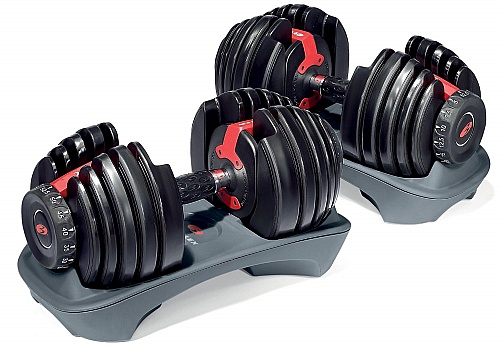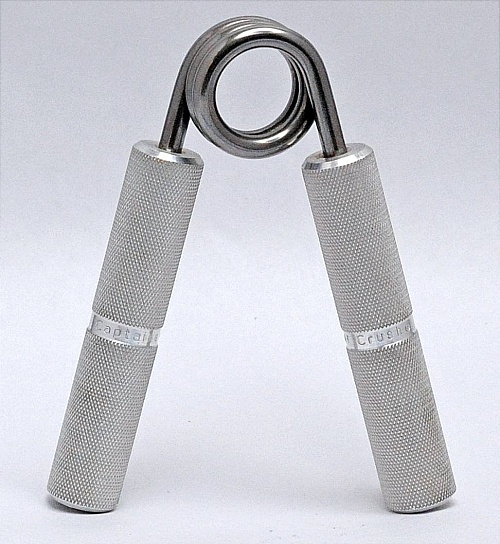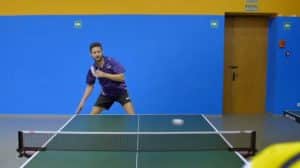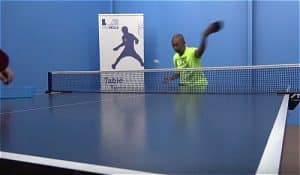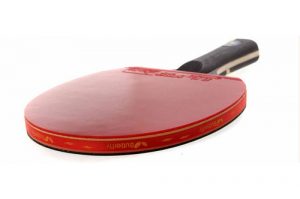When I first started to play table tennis, my forearm felt a little sore and tired after just an hour of practice. After consulting my coach, he advised me on the following:
- When holding the bat, your hands should be relaxed. You don’t need to tense and grip the bat hard at all.
- If you are using the shakehand hold, it is crucial that your index finger isn’t pointing upward. It produces extra pressure and fatigue on your hand. Your index finger should almost be a little bit curled in.
After doing the above, I didn’t feel any more pain in my hands. I feel great that my problem is being solved.
But hold on a second,
Whenever you take part in any physical activity, you need to do some weight training too. Weight training improves your performance and prevents you from injuries, believe it or not.
Let’s take the example of a sprinter. For anyone to improve on their speed, they will need to work on their twitching muscle to give them that explosive speed, right? And how do you achieve that? Weight training, of course.
Since we are talking about the wrist on this post, we will restrict ourselves to workouts that you can perform to improve your wrist muscle or tendons pretty obvious.
I know that there are many more exercises out there, but the following set of workouts helped me with table tennis and Thai boxing. (Yes, I do boxing)
You probably heard this a hundred times before, but before you take part in any physical activity, you should always warm-up. Here is a quick video showing you how to warm up your wrists and get them stronger. Perform the exercise for about 10 to 15 minutes, but it’s up to you if you want to do more.
Table of Contents
Wrist Exercise
Bicep Curls
The bicep curl is one of my favorite exercises. You only need a light dumbbell and you are ready to go. Check out this great video I found:
Hand grippers
All hand grippers come in different strengths, so if you feel that your wrist is really weak, I suggest you go with the lowest strength and build it up from there.
When you move up to a more robust hand gripper, don’t feel disappointed if you cannot fully close. It’s OK to do partial or even assisted reps until you are vital even to them without support.
Wrist Strengthening Exercises
Ever feel like your forearm muscles are about to give when you are playing table tennis after some time? Or maybe you’ve experienced wrist pain simply because you put pressure on your hands.
Well, I’ve been there.
As a kid, I broke my wrist. Let’s rephrase that… I snapped it in half. I had fallen a good six feet after jumping a fence, and the aftermath looked like something out of a horror movie.
Anyway, I don’t want to put you off, but I know what it’s like to have weak wrists. Couple that with the fact that I am naturally a “skinny guy,” I’ve always struggled with wrist pain and lack of grip growing up.
So, like most folks who make a change, mine came out of desperation. I was fed up with always being in pain when I was trying to play table tennis or even carry heavy objects.
How To Strengthen Your Damage Wrist?
That led me to study grip and wrist strengthening exercises. One of my favorites is using a Russian Kettlebell. If you don’t know what they are, you have to check them out. They are awesome.
Another exercise I use to strengthen my wrists is to hold onto a pull-up bar and hang above the ground for as long as I can. It helps to build up wrist strength endurance too. All these you can do at home.
Forearm Exercises – Why You Must Do These 3 Essential Forearm Exercises
Forearm exercises should play a critical part in your overall fitness regime if you want to play well in table tennis. Not only will strong forearm exercises add to the physical appearance of your arms, but they will also help play a more important role, that of providing wrist & grip strength as well as preventing wrist injury.
Below I have listed three forearm exercises that you should regularly consider to form the foundation of an excellent overall wrist exercises program.
Before performing any forearm exercises, start by correctly warming up by doing some form of wrist stretch to help warm up the surrounding forearm muscles and loosen the wrist joints.
Here are the three essential foundation exercises you should be doing.
Wrist Curls – This exercise will help build the inside forearm muscles and add grip strength and wrist stability to help prevent injuries in the future, such as golfers elbow.
Reverse Wrist Curls – The same as the above exercise, except your palms start off facing you. This exercise is responsible for developing the exterior forearm muscles and will often give you a defined look at the top of your forearms. This exercise is also great for building wrist strength and can help prevent sport-related strains such as Tennis elbow.
The Hand Gripper – Although it may not be thought of as a conventional forearm exerciser, the hand gripper has earned its place as a top wrist exerciser/forearm exercise tool. Despite appearing only to be working the hand muscles, the forearm muscles’ predominant benefits are why many individuals relate to feeling a burning sensation in their forearms after using the hand gripper.
5 Useful Tips for Getting Started in Wrist Exercises
Whether you’re looking to build forearm and grip strength to help make daily activities more straightforward, such as carrying heavy objects or increase wrist stability for peace of mind, then wrist exercises are the way to go. Still, first, there are some essential things you need to know before you begin.
Just follow these five tips for getting started in wrist exercises.
1. an essential factor before you start any new exercise or training program is to make sure that you are fit enough to engage in the given activities. It is therefore recommended that you consult your doctor or GP in advance.
I appreciate that wrist exercises engage only a small amount of muscle tissues and joints. Yet, it is still essential to get the all-clear as you don’t want to injure yourself or aggravate any pre-existing conditions like preventing Carpal Tunnel Syndrome.
If you don’t get yourself checked, then you run the risk of making things worse for yourself in the future. So it’s better to be safe than sorry.
2. Another vital consideration for wrist exercises is deciding what type of activities you should undertake (e.g., reverse forearm curls, stretching, etc.) and what equipment will be required (dumbbells, barbells, grip stick).
It’s critical that you buy equipment from a reputable supplier, especially where exercise equipment is concerned, as you don’t want something going wrong during training. Also, try to look out for good product reviews, and you should be fine.
3. You don’t have to train your wrists daily as the supporting muscles in the hands and forearms are like any other muscle groups and require rest to grow stronger. So make sure you get at least 48 hours rest between direct wrist exercises and forearm training to allow ample time for recovery.
4. Instead of complicating your wrist training by doing a large number of different exercises, try starting with just one workout at a time and seeing how you feel.
You can then slowly add extra exercises as you progress. Try to keep the rep ranges relatively high (above 15 reps) as this will build wrist strength and increase forearm endurance.
5. Have you considered adding wrist exercises to your table tennis training? It’s not as difficult as you might think. You need to conduct your training as usual and finish off with your wrist training program. It is because training your wrists intensively may temporarily reduce grip strength, and you don’t want to weaken your grip before conducting your other exercises, so it’s best to leave them until the end.
Forearm Workout – How to Perform the Reverse Wrist Curl
The Reverse Wrist Curl is an essential part of your overall forearm workout. This forearm exercise is one of the main forearm exercises used to build forearm strength and size.
A bodybuilding favorite, the Reverse Wrist Curl, also known as wrist extension, is also highly popular amongst other athletes, especially arm wrestlers, who rely heavily on superior forearm and wrist strength.
I prefer to use a barbell (although dumbbells are also a viable option). It allows me to complete the exercise quicker than working one forearm at a time. Yet, I do not have to sacrifice technique or intensity in the process.
This particular forearm workout works the extensor carpi radialis longus, the extensor carpi ulnaris, and the extensor carpi brevis. In plain English, they are the muscles that run from the humerus to the metacarpal bones in your hands.
Performing these forearm/wrist exercises regularly will help increase wrist stability while also adding definition to the outside upper portion of your forearms.
Note – I recommend you start with a lightweight and focus on correct technique and repetitions, to begin with. You can later move up to a heavier weight if desired. Aim for around 12-15 reps.
Performing the Forearm Workout
- Start by kneeling in front of an exercises bench with your forearms resting across the bench.
- Holding the barbell with both hands, palms facing down, fists closed, and knuckles toward the floor, slowly raise the bar until your knuckles are facing upwards.
- Hold this position for a count of one, squeeze for maximum contraction and blood flow, and slowly lower the barbell to the starting position.
- Once back at the starting position, hold for a further 1 seconds and repeat the process until you have reached your desired rep count.
Remember – Just as with the standard wrist curl, increase wrist strength, and the reverse wrist curl should always be executed with the strictest form as it is an essential part of your forearm workout program.
Choosing The Right Wrist Exerciser – Where to Start?
So how do you choose the suitable wrist exerciser to suit your needs? Well, the answer lies in the question. You start by identifying “your needs”!
After all, with all the wrist exercisers and wrist exercise tools in the marketplace, it’s relatively easy to get confused.
So first, you have to ask yourself, what if you want to achieve?
Are you simply looking to build stronger wrists for general purposes, such as carrying your groceries home or overcoming an old injury? Are you looking to develop your wrists and hands for a specific sport such as golf or baseball? Only you know the answer to this question.
And with that said, I have compiled a list of the best wrist and grip training tools available and included descriptions of each and what they are most suited for to help you make up your mind and maybe point you in the right direction.
So here they are:
The Russian Kettlebell
The Russian Kettlebell is a great wrist exerciser that has many uses. While it does strengthen your wrists, it also helps develop many other muscle groups, including improving your overall core strength. Kettlebells are popular with a variety of athletes ranging from mixed martial arts to golfers.
Compared to many other wrist exercises, I wouldn’t say it’s only suitable for one particular muscle group. Instead, I recommend you use iron kettlebells as part of all of your wrist training endeavors.
Gripstik Wrist Exerciser
The Gripstik is not only great for developing wrist strength, forearm muscles, and upper arm muscles, but it can also be used to speed up the rehabilitation process after an injury as well as relieve aches and pains caused by repetitive motion.
While it will build wrist strength, its strength benefits will be limited to only the wrists’ muscle groups. Therefore making the Gripstik a true wrist exerciser.
This wrist exercise tool especially great for athletes such as ice hockey players, climbers, and motor cross riders.
Captains Of Crush Hand Gripper
Captains of Crush are great for developing wrist and grip strength. Still, as the primary movement relies on the handgrip’s opening and closing at various degrees of resistance, the main benefits will be in handgrip strength rather than wrist strength.
Although many other wrist building exercises can be performed with these grip training tools.
This grip strength tool is excellent for athletes who rely on the firm grip as part of their sport, such as baseball, tennis, badminton, and table tennis. The Captains of Crush is also great for individuals who want to build up their overall grip strength.
Gripmaster Pro Hand Gripper
Like the Captains of Crush, the Gripmaster pro is a hand exercise tool that mainly focuses on building hand strength. You can perform many handgrip exercises with the Gripmaster Pro series, and they come in varying degrees of resistance.
The main difference between the Gripmaster Pro and the Captains of Crush is that the Gripmaster Pro works individual fingers and forces each finger to work on its merit, preventing one part of your hand’s muscle groups overcompensating for the other.
This hand and wrist exerciser is also suitable for athletes who rely on a firm grip, like play table tennis.
The Marcy Wedge Wrist Exerciser
The Marcy Wedge Wrist Exerciser is one of my favorite wrist exercise tools as it is so easy to use, but in its simplicity lies its genius. You put your arm inside the device and pull the hand down toward your forearm for as many reps as you can handle.
The great thing is that you can adjust it from level 1 (which is easy) to level 5 (for advanced users). Not only will this give your forearm a great workout, but it will also simultaneously make your wrists much stronger.
The Marcy Wedge can be used at the gym or sitting in front of your TV to give you a significant wrist and forearm workout on the fly.
Dynoflex Powerball Gyroscope
The Dynoflex Powerball Gyroscope is the mother of all wrist exercisers!
By isometrically putting your hand, wrists, and shoulders to the test, it forces stabilizer muscle groups to develop that you never knew you had. It is proven to help improve results in swing based sports, which include table tennis.
It’s also proven to help sports performance such as mountain biking, motocross, cycling, climbing, hockey, fencing, rowing, and even basketball.
It increases the distance of each shot and allows the user to gain more accuracy by developing greater arms control.
The great thing about the Dynoflex Powerball Gyroscope is that you can use it on the move. You can take it to the park or work and be guaranteed a great workout in minutes.
This wrist exerciser is a must-have for any looking to build serious wrist and grip strength.
Dynaflex Pro Sports Gyroscope Wrist Exerciser
So you’re looking for a quick way to build up your wrist strength. Well, then a wrist ball may be for you. With all the different wrist and forearm exercise tools available, the Dynaflex Pro Sports has quickly made itself to the top of the heap.
So what makes the Dynaflex Pro Sports Gyroscope so unique?
Well, unlike most wrist exercise equipment, this wrist exerciser does not require lifting heavy weights or doing any bodyweight exercises, which is excellent if you are not a naturally strong individual.
It cleverly uses the momentum that you create by rotating the device in your hand, creating counter-resistance simultaneously! The great thing is, the faster you go, the more resistance it adds… which in turn forces your wrist and forearm muscles to get stronger in the process.
The fact that it easily fits into the palm of your hand makes this wrist ball convenient and easy to take out and about with you. You could be stood at a bus stop listening to your MP3 player and build strong wrists, grip, and forearm strength at the same time.
It’s also great fun. As a side benefit, the therapeutic vibrations you feel when using the Powerball Gyroscope wrist ball can also help relieve stress, which is excellent if you are constantly under pressure from your studies or job.
So what’s the best use of the Dynaflex wrist ball?
The great thing about the Dynaflex Pro is that it can be used for various purposes. As it helps build wrist strength, it is excellent for you to build up your wrist and forearm muscles without doing any heavy lifting and is hugely beneficial for those who play sports that require a firm grip, wrists, and forearms.
Treating Wrist Injuries
You were trying to twist your wrist to generate a strong spin for your stroke, but you exert too much of your strength, and you accidentally hit your wrist with the table, which injured your wrist bones. You feel discomfort as your wrist absorbed the shock, and you start to feel the pain.
The next morning you awake, having forgotten about the incident from the previous night. As you roll over and sit on the edge of the bed, you feel pain in your wrist, and it all comes back to you.
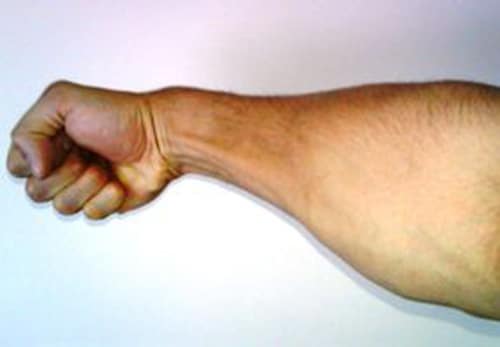
After an injury occurs, it sometimes takes a while for the condition’s signs to make themselves known. With this kind of damages, rest is often the only treatment needed; and even when more extensive treatments are required, rest is still part of the treatment routine.
It is familiar with wrist injuries, such as a sprained wrist, for swelling to develop. It is an easily recognized indicator that something is wrong. You may feel numbness in the hurt area. In either case, seeking medical attention is recommended.
Of course, not everyone wants to see a doctor, especially when they don’t think they are in any immediate danger. Suppose there is no noticeable change in the area that might indicate a break or other serious problem, and there is no severe pain. In that case, you might want to take Tylenol or Advil and place the hurt hand joint in a comfortable position, maybe on a pillow, and see how it feels a little later.
As with so many injuries, applying a heat pack to the affected area can limit potential swelling. It will generally take some time for the swell to get away by using a heat pack on the wrist. You don’t need to seek a doctor who tends to worsen the situation rather than have your wrist cure faster.
Wrist Exercises To Prevent Carpal Tunnel Syndrome
Cases of carpal tunnel syndrome seem to be occurring more and more on table tennis players. There are preventive measures that you should take to lessen your chances of developing the condition.
Not everyone is familiar with carpal tunnel syndrome, so here is a little about the condition. It occurs when the median nerve which runs through the carpal tunnel is compressed at the wrist. The situation is common in people who continually perform repetitive movements involving the hands.
Playing table tennis is readily identified as one of the potential culprits of the ailment. Some people compare the pain involved to that associated with a sprained wrist.
These preventive wrist tips are for table tennis players:
- Get in the habit of getting into a comfortable position that promotes all-around good posture.
- Holding the racket with the proper grip with slightly elevated, never slanted downward.
- The wrists should remain straight, and the elbows follow to swing with the wrist when playing.
- Relax your wrists when you are not playing.
- Take more short breaks. It is better than a combined long rest.
- During breaks, do wrist exercises.
Now, here is one of many hand/wrist workouts without equipment that you can perform, and it should help regardless of the sports you are playing.
- Extend your arms in front of you.
- Lift your palms. The hands will be in the waving position. Hold this position for five seconds.
- Straighten the wrists and relax the fingers.
- Keeping the wrists straight, make a fist and squeeze hard. Hold for five seconds.
- With fists still clenched, bend wrists down. Hold for five seconds.
- Straighten wrists and relax fingers.
It is the workout during wrist injury. You can repeat these steps five to 10 times. Your hands and finger will probably feel better and more relaxed immediately.
Wrist Pain – a Good Indication that You Need to Rest the Joint
A wrist injury can happen to table tennis, where a player must throw, catch and perform the even more demanding task of swinging a bat. A sprained wrist can be enough to put a player on the disabled list for a considerable stint.
Rest is vital for recovery in this type of situation. For a person who does not have a job that constantly puts pressure on the wrist, recovery can be easily managed as the individual goes about a regular daily routine that can include work.
However, if your profession is table tennis that requires grasping, gripping, and lifting, you may need to take some time off.
If an injury occurs to the small bones and ligaments in the wrist, instability can result. When these small carpal bones and ligaments are damaged, normal movement is impaired. It can result in friction and wearing away of cartilage, and eventually, the joint itself can be compromised.
You may find it surprising to learn that arthritis can result because of such trauma. Post-traumatic arthritis develops when an injury to cartilage causes the joint surface to erode. It is more likely to happen when there is a fracture associated with the joint’s cartilage surface.
You should take any wrist pain seriously. Usually, rest will cure the problem, but discomfort could be a sign of an ailment that requires medical attention.

Warren Davies

